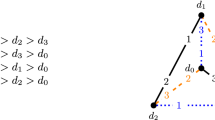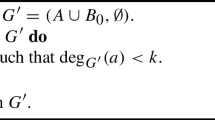Abstract
Given a bipartite graph \(G = (A \cup B,E)\) with strict preference lists and given an edge \(e^* \in E\), we ask if there exists a popular matching in G that contains \(e^*\). We call this the popular edge problem. A matching M is popular if there is no matching \(M'\) such that the vertices that prefer \(M'\) to M outnumber those that prefer M to \(M'\). It is known that every stable matching is popular; however G may have no stable matching with the edge \(e^*\). In this paper we identify another natural subclass of popular matchings called “dominant matchings” and show that if there is a popular matching that contains the edge \(e^*\), then there is either a stable matching that contains \(e^*\) or a dominant matching that contains \(e^*\). This allows us to design a linear time algorithm for identifying the set of popular edges. When preference lists are complete, we show an \(O(n^3)\) algorithm to find a popular matching containing a given set of edges or report that none exists, where \(n = |A| + |B|\).










Similar content being viewed by others
References
Biró, P., Irving, R.W., Manlove, D.F.: Popular matchings in the marriage and roommates problems. In: Proceedings of 7th CIAC, pp. 97–108 (2010)
Cseh, Á., Huang, C.-C., Kavitha, T.: Popular matchings with two-sided preferences and one-sided ties. In: Proceedings of 42nd ICALP, pp. 367–379 (2015)
Dias, V.M.F., da Fonseca, G.D., de Figueiredo, C.M.H., Szwarcfiter, J.L.: The stable marriage problem with restricted pairs. Theor. Comput. Sci. 306, 391–405 (2003)
Feder, T.: A new fixed point approach for stable networks and stable marriages. J. Comput. Syst. Sci. 45, 233–284 (1992)
Feder, T.: Network flow and 2-satisfiability. Algorithmica 11, 291–319 (1994)
Gale, D., Shapley, L.S.: College admissions and the stability of marriage. Am. Math. Mon. 69, 9–15 (1962)
Gale, D., Sotomayor, M.: Some remarks on the stable matching problem. Discrete Appl. Math. 11, 223–232 (1985)
Gärdenfors, P.: Match making: assignments based on bilateral preferences. Behav. Sci. 20, 166–173 (1975)
Gusfield, D., Irving, R.W.: The Stable Marriage Problem: Structure and Algorithms. MIT Press, Cambridge (1989)
Huang, C.-C., Kavitha, T.: Popular matchings in the stable marriage problem. Inf. Comput. 222, 180–194 (2013)
Irving, R.W., Leather, P., Gusfield, D.: An efficient algorithm for the “optimal” stable marriage. J. ACM 34, 532–543 (1987)
Kavitha, T.: A size-popularity tradeoff in the stable marriage problem. SIAM J. Comput. 43, 52–71 (2014)
Knuth, D.: Mariages Stables. Les Presses de L’Université de Montréal, 1976. English translation in Stable Marriage and its Relation to Other Combinatorial Problems, volume 10 of CRM Proceedings and Lecture Notes, American Mathematical Society (1997)
McDermid, E., Irving, R.W.: Popular matchings: structure and algorithms. J. Comb. Optim. 22(3), 339–359 (2011)
Rothblum, U.G.: Characterization of stable matchings as extreme points of a polytope. Math. Program. 54, 57–67 (1992)
Acknowledgements
Thanks to Chien-Chung Huang for useful discussions which led to the definition of dominant matchings.
Author information
Authors and Affiliations
Corresponding author
Additional information
Á. Cseh was supported by the Hungarian Academy of Sciences under its Momentum Programme (LP2016-3/2016), its János Bolyai Research Scholarship and OTKA Grant K108383. Part of this work was carried out while she was visiting TIFR.
Rights and permissions
About this article
Cite this article
Cseh, Á., Kavitha, T. Popular edges and dominant matchings. Math. Program. 172, 209–229 (2018). https://doi.org/10.1007/s10107-017-1183-y
Received:
Accepted:
Published:
Issue Date:
DOI: https://doi.org/10.1007/s10107-017-1183-y




